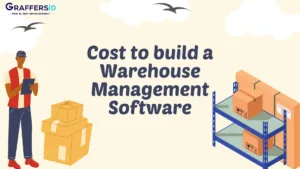Warehouse Management System (WMS) is very important for any organization since it helps them control their inventory, improve the overall efficiency of operations, and optimize processes. Very often, standard WMS solutions are just not aligned with specific workflows.
On the other hand, customized WMS solutions guarantee that the organizational software is going to meet all the exact specifications. It also ensures that it blends well with other enterprise systems already in place; for example, an ERP and accounting software to synchronize data automatically voiding the need for manual data extraction.
Nevertheless, identifying a warehouse management software solution that is tailored to your organization’s needs is a strategic investment with long term gains. When it comes to budgeting and making informed decisions, it’s important to consider how big of an impact this issue has financially. This task may seem impossible at times but if you take into account multiple factors, it becomes possible.
In this article, we will consider what parameters influence WMS cost and give useful insights into specific financial considerations that should be looked into when implementing WMS.
What is Warehouse Management System?
WMS stands for Warehouse Management System, which is software that aims to help improve various processes carried out in warehouses like inventory management, order fulfilment, goods tracking, and space utilization. In fact, it is meant to be an all-inclusive platform for managing all operations of the warehouse from when goods arrive at the door of a building until they stored away in their respective sections; picked up by clients or dispatched elsewhere.
Using WMS can help firms reduce their operating costs while minimizing mistakes made as well as saving time spent doing things in warehouses. For any type of player in this field whether small sized companies or big organizations these materials can be utilized for streamlining activities taking place in their warehouses thereby enhancing productivity level within such entities.
Why is WMS Getting Popular and in Demand?
Nevertheless, in order to understand why WMS retains popularity and demand, one needs to know several key factors driving its growth:
Growth in E-commerce: For starters, there is an upward trend in E-commerce which has seen warehouses come under devastating pressure on efficiently handling massive volumes of orders. Businesses using WMS have been able to handle large inventories; process orders quickly and be able to deliver on time.
Rising Customer Expectations: Customers have raised their bar on speed of delivery and level of accuracy. WMS enables companies reduce order processing time thus ensuring that inventories are tracked in real time while also minimizing cases of stockouts or overstocking hence meeting consumer needs.
Increased Complexity of Supply Chains: Supply chains today are complicated affairs involving multiple distribution centers. This calls for proper tools for managing them as well as optimizing strategies across all available warehouse locations- that’s where WMS fits in.
Increased Accuracy and Efficiency: In the above conditions, field operations within warehouses need precision with minor errors leading to significant losses while at the same time an increase in staff members will only complicate things further. Automating functions like counting inventory items manually picked up or packed reduces human labour leading to greater accuracy within record keeping thus also minimizing commercial risks related to inexactness over entire supply chains leading positive customer feedback saving businesses money on salaries through fewer workers being hired resulting happy clients.
Scalability and Flexibility: The WMS software can be designed specifically for a wide range of sectors. They are easily adaptable to growth in business and altered conditions, whether in manufacturing, retail or logistics.
Factors Influencing the Cost of Warehouse Management System (WMS)
The choice to implement a Warehouse Management System (WMS) in any company is influenced by many factors that must be considered during its cost-benefit analysis. It is important to note that while WMS has several advantages including improved efficiency, reduced errors and streamlined inventory management, its cost could be significantly different depending on simplicity, size and specific business requirements. Below are ten key determinants of WMS price:
1. Kind of WMS (On-Premise vs. Cloud-Based)
One of the most important aspects determining WMS pricing is its type. We have two main categories:
On-Premise WMS: You will need to buy hardware, buy software licenses, and also have permanent IT infrastructure support. This kind usually requires more upfront money but gives full authority over the system to companies.
Cloud-Based WMS: These work under a subscription plan that entails lower upfront payments although there are monthly or annual fees meant for hosting, maintenance as well as upgrades. This type permits flexibility and scalability more than on-premise thereby making charges contingent upon the number of users or how congested the warehouse is.
The choice between on-premise and cloud-based will depend largely on factors such as affordability, control preferences, as well as scalability necessities.
2. Volume and Heaviness of Warehouse
The cost of WMS is directly affected by the cumbersome size and intricate features of a warehouse or warehouse operation. Larger warehouses or establishments that operate in various locations need stronger systems that can deal with enormous amounts of stock, complicated processes and increased users’ access.
Big Warehouses: They may require more advanced features such as multi-warehouse support, sophisticated inventory control and complicated picking/packing processes.
Small to Medium-Sized Warehouses: They may need fewer functions but they might still need to have a few specialized functions for the specific work to be done.
The higher the volume and complexity of a warehouse design, the greater the expense incurred in implementing a WMS.
3. Number of Users and Licenses
With regard to WMS, the standard procedure is that the providers determine the payment method depending on how many people will be using it. Consequently, the more users you have, the higher your expenses will be because a fee must be paid for every individual license or point of access especially in case of cloud-based solutions.
User-based pricing is a major approach most WMS vendors take into account when selling their products. The warehousing personnel’s size usually informs this as well.
For instance, if a particular warehouse happens to accommodate many users working at different times during day and night shifts then it follows that prices will rise progressively. Besides, some companies also impose restrictions regarding access control based on roles thus making the licensing process even complicated and expensive.
4. Customization Needs
Every business has its own operational processes, and as such, most WMS solutions cannot meet every individual requirement out of the box. Therefore, custom development so that the WMS aligns with specific workflows of a company will escalate extra expenditure.
Unique Features: Some businesses may require specific reports, workflows or integration with tools related to a particular industry.
Changes: Customizations also involve things like altering user interfaces (UI), dashboards and including industry specific modules.
As demand for customization increases, so do expenses involved in developing it including future maintenance costs that may arise from upgrading or adding to the customized features.
5. Incorporating Existing Systems
A range of software systems that many companies adopt are like Enterprise Resource Planning (ERP), Customer Relationship Management (CRM), or Transportation Management Systems (TMS). It is important to have a smooth operation between these businesses and their existing systems but this can be very expensive.
API Development: The interface that is needed to integrate different systems usually requires a custom Application Programming Interface (API) so as they communicate with one another.
Data Synchronization: This also implies increased implementation cost as well as the cost of keeping it running for an organization hoping to achieve real-time data exchange between WMS and other systems like sales, procurement or shipping.
However, in most cases, the overall WMS cost will increase significantly due to complex integrations especially those involving legacy systems.
6. Training and Support
To implement a successful WMS, Proper employees’ training is necessary for the effective use of this system. Alternatively, the value of support requires before, during and after implementation likewise contribute to costs.
Training Costs: Workshops, online tutorials or even classroom based training sessions are part of these expenses due to need to familiarize warehouse staff with its features and functions in software.
Ongoing Support: these involve post-implementation support, troubleshooting and software updates which are also part of these bills; whereby cloud based systems usually offer them together with subscriptions while on-premise ones might demand separate contracts.
The overall cost of the WMS solution is determined by the extent of training and support required.
7. Logic suggestions
In line with the chosen WMS and the warehouse operations, particular hardware components may be necessary to allow for its smooth running.
Barcode scanners: Without these, tracking inventory and automating the picking / packing process will not be possible.
RFID systems: Some organizations may prefer to use RFID (Radio Frequency Identification) technology for advanced inventory tracking. However, this comes at a cost in terms of hardware.
Warehouse terminals and mobile devices: WMS solutions may call for mobile terminals or handheld devices that can provide real-time access to the system on the warehouse floor itself.
The more advanced and broader the hardware needs are, the greater are the upfront costs of implementing WMS.
8. The Ability of a System to Grow Bigger
Some organizations require a WMS solution that grows with their activities. A scalable WMS is initially expensive, but this helps to protect future growth of the company system.
Modular WMS Solutions: When businesses grow in size, instead of completely changing the system, they can simply add more modules or users to their existing WMS as part and parcel of the processes (operations). However, this calls for more complicated initial development and customization that comes at an extra expense.
Choosing such a WMS is one way of ensuring it is flexible and scalable enough for future business requirements; hence more expensive at first sight but it cuts down on chances of implementing it again later on.
9. Data Migration & Setup
The task of transferring the archived systems or worksheets to a new WMS usually takes time & is very complicated which may require cleansing of data so as to suit the new system.
Data Migration: Transferring inventory data, customer information, and historical records from the old system into the WMS can take some time and it might need data cleansing and restructuring to fit in the new system.
Initial Setup: The process of setting up the WMS, including configuring workflows, roles, permissions and system preferences, can increase costs even more especially if you have complex operational needs at your warehouse.
Generally speaking when it comes to migrating data; elaborate processes are always associated with high expenses.
10. Maintenance!
In order to keep the WMS operational and practical over an extended period of time, consistent maintenance and software updates are important.
Software Updates: When businesses expand or WMS vendors offer new capabilities, it might be necessary for companies to elevate their systems, which can incur extra charges especially when dealing with on-premise WMS solutions.
Maintenance Contracts: For WMS operating in the cloud, maintenance is usually part of the subscription; nevertheless, for on-premise systems separate maintenance agreements may be needed.
The total expenditure associated with owning a Warehouse Management System should include timely revisions as well as long-term support fees.
Conclusion
In conclusion, a Warehouse Management System (WMS) is a pivotal tool for organizations aiming to streamline operations, reduce costs, and improve efficiency. While off-the-shelf solutions may suffice for some businesses, customized WMS solutions offer the flexibility and scalability needed to address unique operational challenges and seamlessly integrate with existing systems like ERP or accounting software.
Investing in the right WMS is a strategic decision that requires careful consideration of factors like warehouse size, customization needs, system integration, and scalability. Although the implementation process may seem daunting, the long-term benefits of enhanced accuracy, improved productivity, and cost savings make it a worthwhile endeavor.
Ultimately, selecting the right WMS tailored to your organization’s specific requirements ensures a solid foundation for growth and operational excellence. At GraffersId, we can build you your very own WMS customized to your specific needs. Contact us today!




